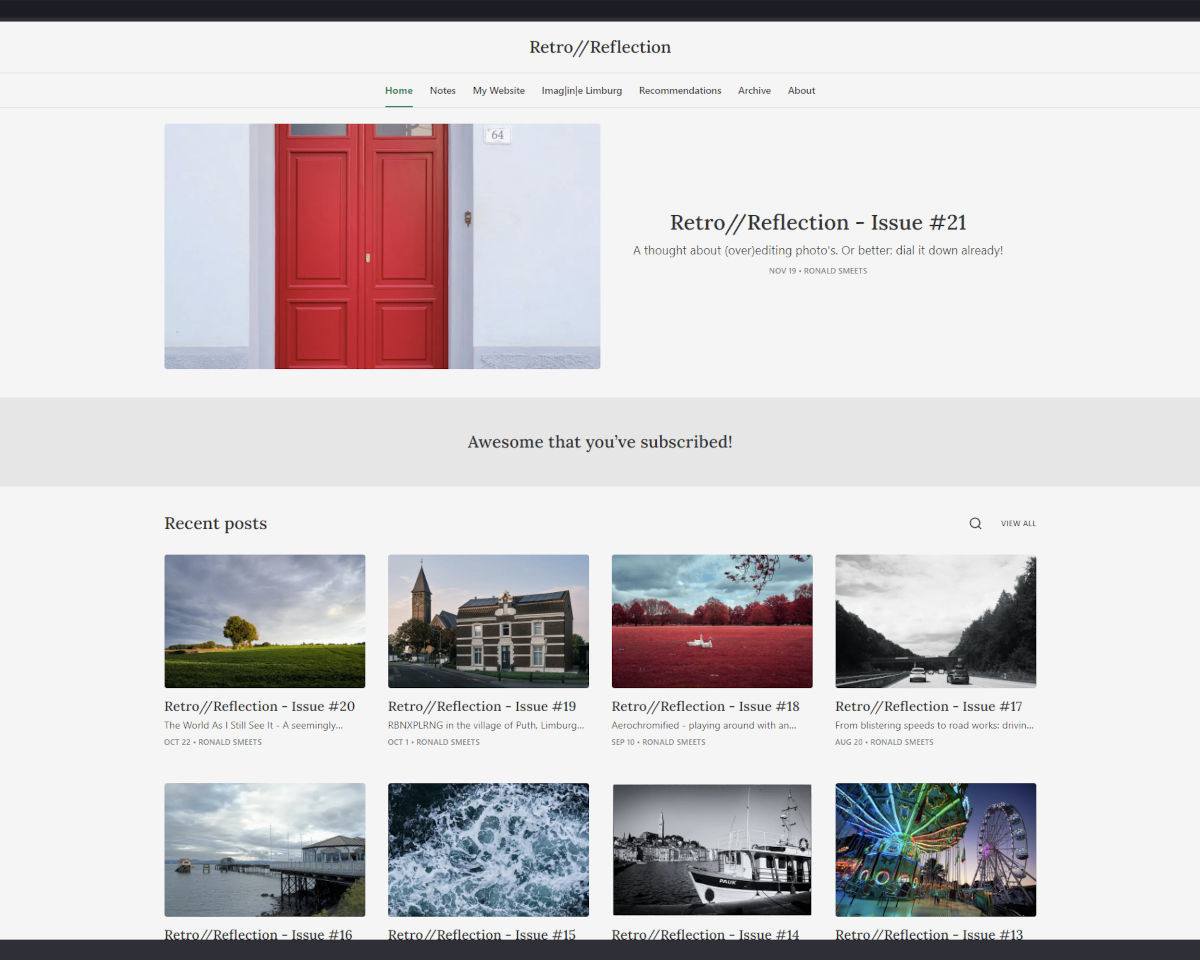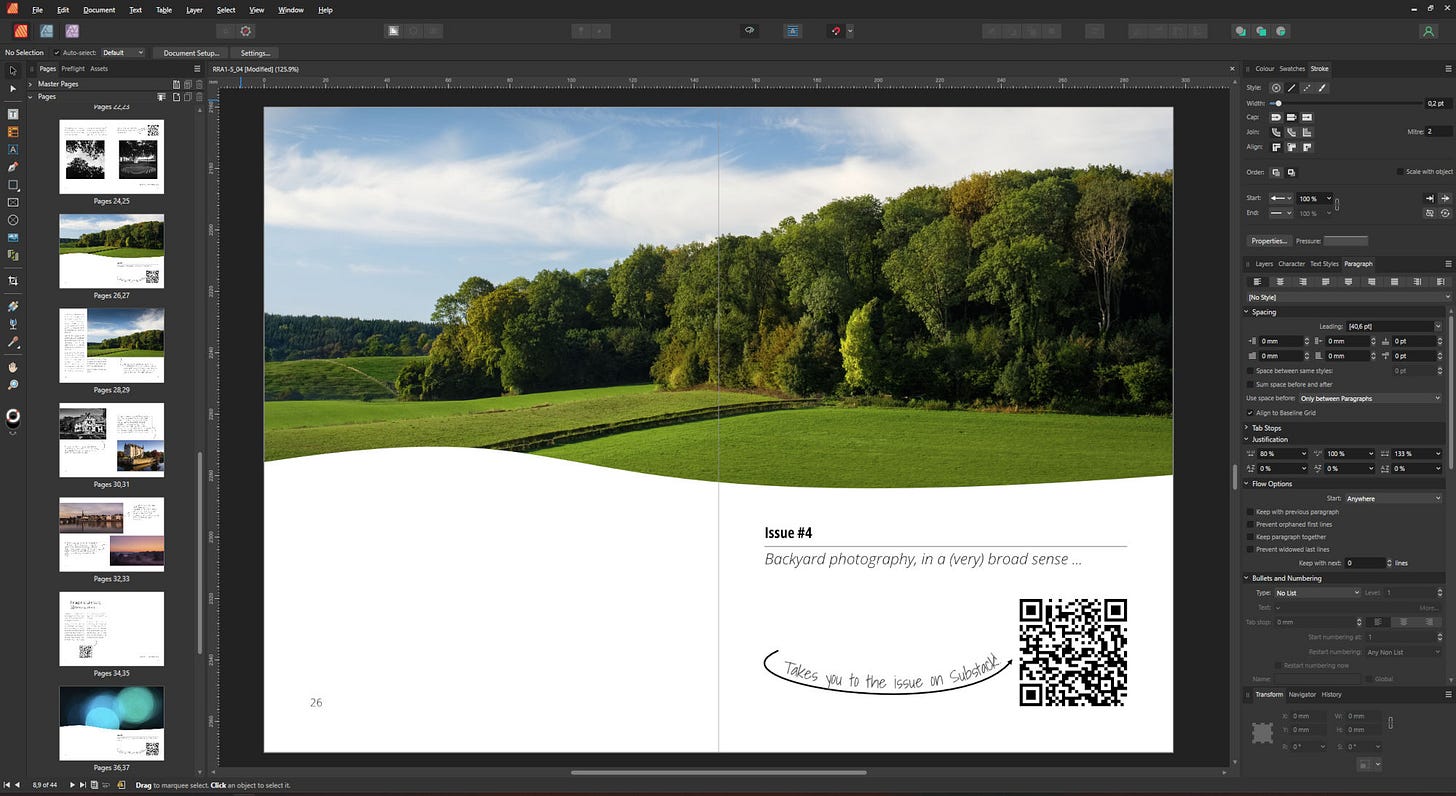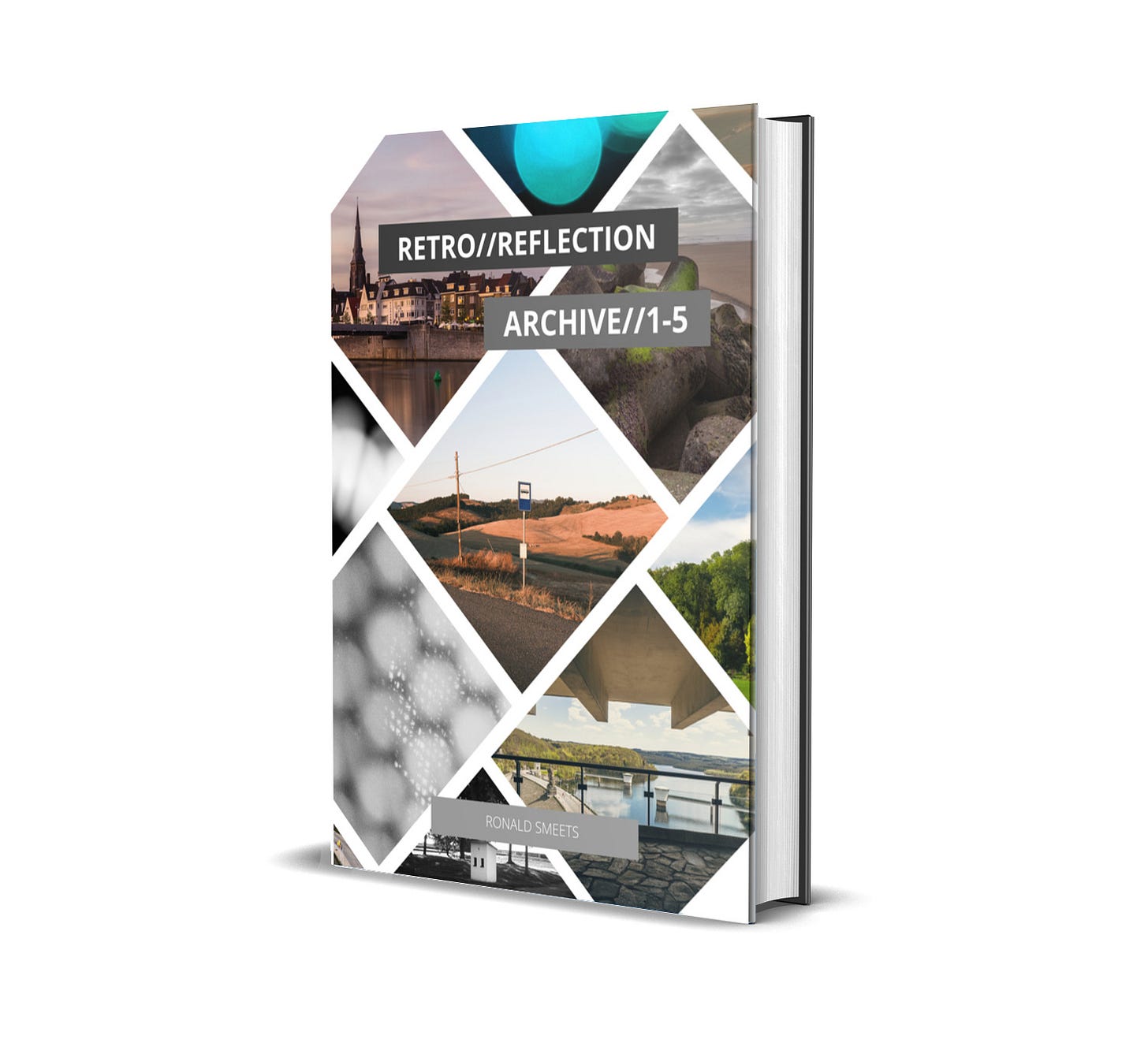Retro//Reflection - Issue #22
One way to archive every (digital) thing you create? Create a Zine!
Once or twice per month I send out a letter with a handful of (my) photographs and share a bit of insight on the ‘why?’ or ‘how?’. As an enthusiastic photographer, anything goes.
Maybe you’ll learn something?
Or perhaps it will spark some inspiration?
I started writing these posts slash newsletters using the Substack platform about 14 months ago and while this has been a nice way of “doing more with my photographs”, it has been in the back of my mind that this is yet another (digital) platform that could change course at any moment in a direction I rather not want to follow.
It was also brought to my attention that I don’t really have a backup of all these posts slash newsletters. I mean, I start writing directly from the Substack post editor, save it a hundred times as a draft and then, at some point, continue to publish them. But that’s it. I send myself a newsletter1, but other than that - it all lives on the Substack platform.
So I want to do better to preserve everything I write and publish (here) … I want to create an archive, a Retroreflection Archive.
Now sure, some might suggest to just copy-paste these on to my website. And I already considered that. But I want to do something different.
Then I remembered that a while ago I purchased Affinity Publisher (they ran a promotion so it was a really good deal) with the idea in mind to have a proper tool to create ‘zines’ (one of my long-term plans idea’s to actually print my photo’s). But up to now I didn’t have the time to dive into the program.
Until this idea of an archive came up: why not create an zine of my Retroreflection posts?
Now I had to come up with a bit of a plan on how to start this, before it all would become too much work to tackle. I mean, it’s supposed to be fun too, right? Creating these Archive-zines would also be good practice to learn how to make proper photo zines or -books (eventually).
Some of the major things to tackle:
Get familiar with the interface of Affinity Publisher. To do that I simply watched a few basic and advanced tutorials on Youtube. Turns out, if you ever worked with any sort of graphics editor - Lightroom, Photoshop, GIMP, Affinity’s own Photo, doesn’t really matter: Affinity Publisher is not that different. Sure there are plenty of buttons, tools, options, ways to do something but I didn’t find it overly complicated. In the end you typically just use four or five tools anyway :)
Figure out how many Retroreflection issues would fit in one zine (keeping in mind I might even *gasp* print it). I made an educated guess that 5 per volume would be a good amount. During the design I noticed that each issue would take up around 6 pages, so that would be 30 pages in total - excluding any front and back cover and any other pages I might want to add.
Figure out what to exclude. Like any good photograph, it’s also about excluding anything that would not be logical to have in a (printed) zine. For example: clickable links. I could leave them in for a digital PDF version of the zine, but I chose to leave them out. Where applicable I created a QR-code to link to - a handy feature of Affinity Publisher can automatically generate a QR-code for you. Another consideration: each post slash newsletter has a header and footer - would be a bit odd to include that 5 times over, so I added the “header” once at the beginning of the zine and left out the “footer” all together.
Figure out what to add or change. Each issue is presented as a “chapter” so it would make sense to design a nice chapter page for each. Also I grouped all the “mentions” (at the end of each issue) onto one page. Lastly I designed a cover for the zine and even added a colophon, just because I can2.
Try not to go overboard with all kinds of design elements. Keep it simple, stupid!3
After that I set out designing the first volume: Retroreflection Archive 1-5. As a first go at this zine-making-thing, I think it looks all right.
To keep this within reasonable reading time, a next issue of Retroreflection will about the actual design and use of Affinity Publisher. The lessons learned if you will. If you are considering using Affinity Publisher as well, I recommend looking out for that issue ;-)
To actually end this post: I’ve uploaded the finished (digital) zine to my Ko-Fi page where you can download it for free (or if you want to make a small contribution I won’t stop you).
Let me know what you think! If you have any tips or tricks about Affinity Publisher, please share. Or if you have any questions please feel free to ask! I’m happy to help :)
Each issue I want to end with mentioning a photographer, a photography-related website or publication, simply to show my appreciation for what they do.
I remember reading before on Substack about turning publications into a (digital) zine, and I had to dig deep to find it again. But I think it was
in this post:Besides that article,
is well worth following, because it offers thoughtful insights about photography and a lot of tips, tricks and ideas.That’s it for this issue. Thank you for reading until the end. Feel free to leave a short comment or message. Appreciate it!
Until next time, cheers,
Ronald
ronaldsmeets.info
ps: this article/newsletter/post is free, because I’m not doing this to make a profit. Also, I don’t like subscriptions at all (Tom Pendergast has a great article about not going paid, which I agree with). However, if you do want to show your support, a coffee always helps me writing and posting here ;-)
Not sure how good e-mail is as backup medium :)
Again, creating these Archive-zines is also about learning how to properly design books and magazines
Not sure if I succeeded :)








Sounds like my situation with Affinity Publisher. I use Photo, and when they updated to v2 the deal for the whole suite across all platforms was too good to pass up. So I’ve never used it for anything substantial. But I’m also planning to start making zines so I guess I’m already set for that!
Very interesting and a great first effort Ronald. Affinity looks like an amazing publishing tool and I thought it was interesting how you used Ko-fi for distribution. As a pdf, you are still one step removed from print. Have you printed it out yourself? What did you think of it in print? What physical dimensions did you make it?
I noticed Affinity seems to suggest magazine style layouts with lots of overlays, bleeds and non-rectangular frames, whereas a typical zine might stick to simpler layouts that don't spread images across the fold but present images full frame and in standard sizes. To that extent, I prefer the presentation style of Substack with its limited design elements. What can initially feel restrictive, ends up being liberating because there are so few ways to present content. Those limitations result in an emphasis of content over page design.
I've just invested in a printer, an Epson ET-8550, and look forward to printing more of my images so I can hold them in my hands. I agree with you and Gill that there is something special about this, which eludes digital output. The cost of Affinity seems like a no brainer, but maybe it is overkill for a zine. I know you are just getting started, but how much of a rabbit hole have you found delving into printing zines this way is?